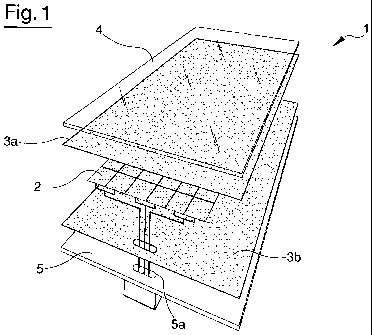Some of the information on this Web page has been provided by external sources. The Government of Canada is not responsible for the accuracy, reliability or currency of the information supplied by external sources. Users wishing to rely upon this information should consult directly with the source of the information. Content provided by external sources is not subject to official languages, privacy and accessibility requirements.
Any discrepancies in the text and image of the Claims and Abstract are due to differing posting times. Text of the Claims and Abstract are posted:
| (12) Patent Application: | (11) CA 2682355 |
|---|---|
| (54) English Title: | A PHOTOVOLTAIC MODULE OR PANEL WITH A CERAMIC SUPPORT SLAB |
| (54) French Title: | MODULE PHOTOVOLTAIQUE OU PANNEAU A DALLE SUPPORT EN CERAMIQUE |
| Status: | Deemed Abandoned and Beyond the Period of Reinstatement - Pending Response to Notice of Disregarded Communication |
| (51) International Patent Classification (IPC): |
|
|---|---|
| (72) Inventors : |
|
| (73) Owners : |
|
| (71) Applicants : |
|
| (74) Agent: | SMART & BIGGAR LP |
| (74) Associate agent: | |
| (45) Issued: | |
| (86) PCT Filing Date: | 2007-04-26 |
| (87) Open to Public Inspection: | 2008-11-06 |
| Availability of licence: | N/A |
| Dedicated to the Public: | N/A |
| (25) Language of filing: | English |
| Patent Cooperation Treaty (PCT): | Yes |
|---|---|
| (86) PCT Filing Number: | PCT/IT2007/000306 |
| (87) International Publication Number: | WO 2008132764 |
| (85) National Entry: | 2009-09-29 |
| (30) Application Priority Data: | None |
|---|
A photovoltaic module (1) comprises a plurality of photovoltaic cells (100), electrically interconnected to define a photo-active surface (2). The photovoltaic cells (100) being closed between a front covering layer (3a) and a back covering layer (3b) which are electrically insulating, the front covering layer (3 a) being frontally covered by a frontal covering element (4) having a mechanical protection function for the photovoltaic cells (100). The back covering layer (3b) being posteriorly supported by a support element, the support element being a ceramic slab of a limited thickness.
La présente invention concerne un module photovoltaïque (1) qui se compose d'une pluralité de cellules photovoltaïques (100) électriquement interconnectées pour définir une surface photo-active (2). Ces cellules photovoltaïques (100) sont fermées entre une couche de couverture frontale (3a) et une couche de couverture arrière (3b) qui sont électriquement isolantes ; la couche de couverture frontale (3a) est couverte à l'avant par un élément de couverture frontal (4) qui comporte une fonction de protection mécanique pour les cellules photovoltaïques (100). La couche de couverture arrière (3b) est supportée à l'arrière par un élément de support, cet élément étant une dalle en céramique d'épaisseur limitée.
Note: Claims are shown in the official language in which they were submitted.
Note: Descriptions are shown in the official language in which they were submitted.

2024-08-01:As part of the Next Generation Patents (NGP) transition, the Canadian Patents Database (CPD) now contains a more detailed Event History, which replicates the Event Log of our new back-office solution.
Please note that "Inactive:" events refers to events no longer in use in our new back-office solution.
For a clearer understanding of the status of the application/patent presented on this page, the site Disclaimer , as well as the definitions for Patent , Event History , Maintenance Fee and Payment History should be consulted.
| Description | Date |
|---|---|
| Inactive: First IPC assigned | 2015-12-18 |
| Inactive: IPC assigned | 2015-12-18 |
| Inactive: IPC expired | 2014-01-01 |
| Inactive: IPC removed | 2013-12-31 |
| Deemed Abandoned - Failure to Respond to Maintenance Fee Notice | 2013-04-26 |
| Inactive: Dead - RFE never made | 2013-04-26 |
| Application Not Reinstated by Deadline | 2013-04-26 |
| Inactive: Abandon-RFE+Late fee unpaid-Correspondence sent | 2012-04-26 |
| Inactive: Cover page published | 2009-12-08 |
| Inactive: Notice - National entry - No RFE | 2009-11-16 |
| Inactive: First IPC assigned | 2009-11-13 |
| Application Received - PCT | 2009-11-12 |
| National Entry Requirements Determined Compliant | 2009-09-29 |
| Application Published (Open to Public Inspection) | 2008-11-06 |
| Abandonment Date | Reason | Reinstatement Date |
|---|---|---|
| 2013-04-26 |
The last payment was received on 2012-04-03
Note : If the full payment has not been received on or before the date indicated, a further fee may be required which may be one of the following
Please refer to the CIPO Patent Fees web page to see all current fee amounts.
| Fee Type | Anniversary Year | Due Date | Paid Date |
|---|---|---|---|
| MF (application, 2nd anniv.) - standard | 02 | 2009-04-27 | 2009-09-29 |
| Basic national fee - standard | 2009-09-29 | ||
| MF (application, 3rd anniv.) - standard | 03 | 2010-04-26 | 2010-03-24 |
| MF (application, 4th anniv.) - standard | 04 | 2011-04-26 | 2011-03-23 |
| MF (application, 5th anniv.) - standard | 05 | 2012-04-26 | 2012-04-03 |
Note: Records showing the ownership history in alphabetical order.
| Current Owners on Record |
|---|
| SYSTEM S.P.A. |
| Past Owners on Record |
|---|
| FRANCO STEFANI |